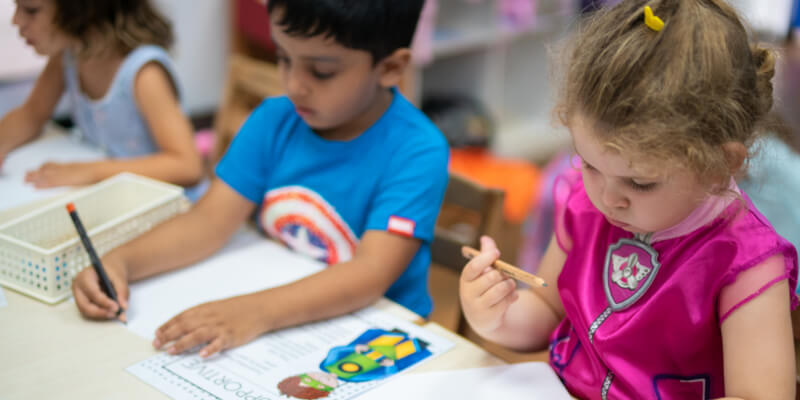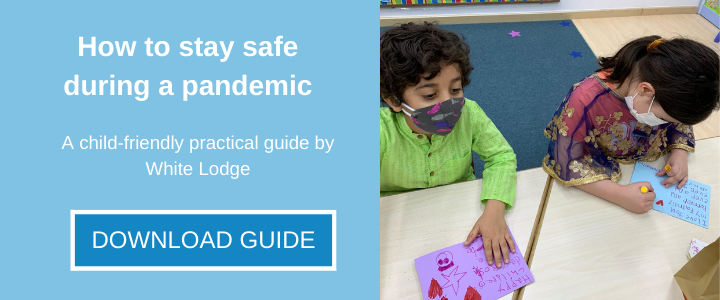Home >
Blog >
Back to preschool after quarantine: tips for parents
Back to preschool after quarantine: tips for parents

May 19, 2020 3:49:48 PM
Due to the COVID-19 outbreak, many preschools and childcare centres have been closed, leaving children to continue their educational journey at home. With White Lodge centres set to open in June, there are a variety of challenges in enabling children to transition back into their normal routine. This blog will discuss strategies parents can use to help their children get back into the preschool routine after quarantine.
WHAT ARE THE CHALLENGES OF RETURNING TO PRESCHOOL?
Time away from preschool can cause disruption in a child’s daily routine. This makes it harder to adjust to the daily schedule when going back to preschool. For instance, waking up early and managing increased activities and workload.
Screen time can also significantly increase whilst at home as children can find themselves with more free time. This can make it harder for them to concentrate when returning to an educational setting where screen time may be limited.
PLANNING AHEAD: WHAT TO DO AND WHEN?
- Morning routine: the key to successfully transitioning back into a preschool routine is starting early. This includes having an effective morning routine. Discuss with your child what their morning routine will look like during the week. This may mean going back to your routine prior to quarantine or developing a new routine. Sit down with your child and list the key things that need to be done in the morning before going to preschool e.g. brushing teeth, washing face, getting dressed, having breakfast, grabbing the lunch box. This will help set expectations.
- The night before going back to preschool: This is an important time as it sets your child up for a successful day ahead. Ensure your child sleeps on time, their outfit is prepared and you have addressed any last-minute questions they have.
- On the morning of returning to preschool: ensure you have set aside some extra time, so you don’t find yourself rushing when any last-minute issues occur.
SETTING BOUNDARIES ON SLEEP AND SCREEN TIME.
Going to sleep on time can be one of the hardest transitions when returning to preschool. Similar to a morning routine, having a night routine can help create a structure for your child.
Simply moving back to their normal bedtime when preschool re-opens can be difficult. An effective approach is to slowly build up to the normal bedtime. The National Sleep Foundation suggests starting two weeks before school begins to develop a sleep schedule. This can include getting your child to go to bed 15-30 minutes earlier than usual in the lead up.
It can be common for children to spend more time watching television or using screens whilst at home, which can easily eat away into sleep time. Setting appropriate screen time limits can help; for instance, stopping all screen usage an hour before your child sleeps.
TALKING THROUGH YOUR CHILD’S FEELINGS
Quarantine can be a confusing and overwhelming time for children. Some may become used to life at home and experience a fear of change. Some may be worried about returning to preschool due to safety concerns. Reassure your child that these feelings are normal and encourage them to ask questions.
Not all these feelings will be negative. For many children, going back to preschool and reuniting with their friends and teachers will be exciting. Emphasising these positive factors about returning to preschool is also a great way to ease any worries.
MORE TIPS ON DEVELOPING A PRESCHOOL ROUTINE
- Getting back to structured mealtimes and naptimes is a great way for your child to fall back into the preschool routine. If possible, try and set this around the time they typically eat and nap during preschool.
- As children spend more time with family members whilst being at home during the day, it can be difficult to deal with separation anxiety when returning to preschool. Take a look at our blog for tips on how to overcome separation anxiety.
- Explain to your child that things may be a little different when returning to preschool e.g. they may have to avoid physical contact with friends for the time being. It is also important to stress the importance of good personal hygiene when going back to preschool.
- Carefully go over the steps of how to properly wear a face mask at home. This will be a requirement when returning to preschool and will make it easier for children to adjust to. Explaining the importance of wearing masks to your child can help them understand why this change it taking place. Letting them know that their teachers and friends will also be wearing masks can help build a sense of normality.
Moving back into a preschool routine after quarantine will not be effective without planning, communication and support. With these strategies in place, your child should be able to practice and develop a routine enabling them to continue their educational and personal journey.
It is important to be patient with your child; it may take some time for them to adjust to the new normal as well as any changes that take place in preschool. The key is setting enough time to plan for these.
Have a question for us about preschool re-opening? Get in touch with us today.
The team at White Lodge have created a free and practical child-friendly guide to staying safe during the pandemic. It’s an engaging story to read to your children while spending time together. Click the button below and grab your copy of How to Stay Safe During a Pandemic.


